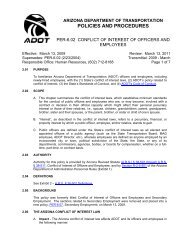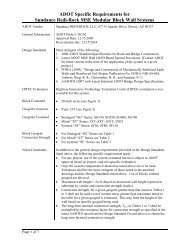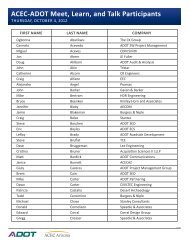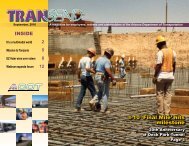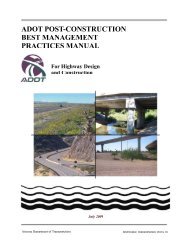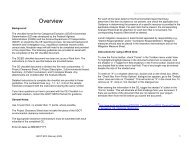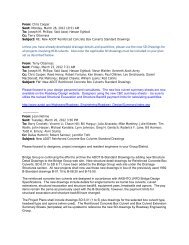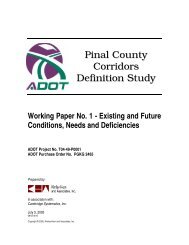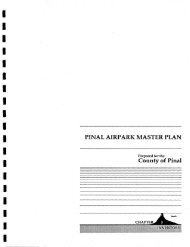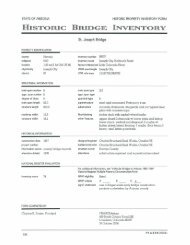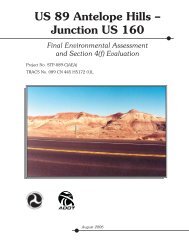I-10 Twin Peaks Traffic Interchange, Environmental Assessment
I-10 Twin Peaks Traffic Interchange, Environmental Assessment
I-10 Twin Peaks Traffic Interchange, Environmental Assessment
You also want an ePaper? Increase the reach of your titles
YUMPU automatically turns print PDFs into web optimized ePapers that Google loves.
Affected Environment and <strong>Environmental</strong> Impacts October 2005<br />
The highest increases (14 dBA, 9 dBA, and 8 dBA at LVR1, LVR2, and LVR3,<br />
respectively) were the result of the relatively large increase in traffic volumes in<br />
the western segment of Linda Vista Boulevard. Currently, Linda Vista Boulevard<br />
in this area experiences total traffic volumes of approximately 60 vehicles per hour<br />
during the peak traffic period. With the completion of the <strong>Twin</strong> <strong>Peaks</strong> Road TI,<br />
traffic volumes in this area are expected to increase to approximately 980 vehicles<br />
per hour during the peak traffic period. The highest increase (14 dBA) was<br />
predicted at LVR1, a residence near the proposed new intersection of <strong>Twin</strong> <strong>Peaks</strong><br />
Road/El Camino de Mañana/Linda Vista Boulevard. In addition to the increase in<br />
traffic volumes, the intersection would be relocated closer to this residence with<br />
the proposed improvements.<br />
As Linda Vista Boulevard moves east of Hartman Lane (represented by receivers<br />
LVR4-LVR26), single family housing is located near the roadway. Although noise<br />
levels were predicted to increase in this area, the increases were considerably less<br />
than those near the interstate. Noise levels along Linda Vista Boulevard east of<br />
Hartman Lane were predicted to increase by 2 dBA to 4 dBA. However, because<br />
of their proximity to the roadway, this relatively moderate increase in traffic noise<br />
levels caused a number of receivers (LVR7 – LVR<strong>10</strong>, LVR13-16, and LVR21) to<br />
approach or exceed the NAC.<br />
Mitigation<br />
Mitigation of Temporary Impacts<br />
Land uses in the project vicinity would be exposed to noise from construction<br />
activity under the preferred alternative. To minimize noise impacts from<br />
construction activities, the contractor shall control construction noise in<br />
accordance with Arizona Department of Transportation’s Standard Specifications<br />
for Road and Bridge Construction, Section <strong>10</strong>4.08 Prevention of Air and Noise<br />
Pollution (2000 Edition). This may include:<br />
• All exhaust systems on equipment would be in good working order.<br />
Properly designed engine enclosures and intake silencers would be used<br />
where appropriate.<br />
• Equipment would be maintained on a regular basis.<br />
• New equipment would be subject to new product emission standards.<br />
Stationary equipment would be located as far away from sensitive receivers<br />
as possible.<br />
Mitigation of Permanent Impacts<br />
Although 49 of the 126 receiver locations were predicted to meet criteria for<br />
consideration of noise mitigation in the 2030 build condition, 11 of these receivers<br />
(Receivers I<strong>10</strong>F1-I<strong>10</strong>F11) were commercial properties near I-<strong>10</strong>. It is ADOT’s<br />
policy that abatement is not considered reasonable for impacted businesses;<br />
therefore, noise mitigation for these 11 receivers was not considered.<br />
Interstate <strong>10</strong> <strong>Traffic</strong> <strong>Interchange</strong> at<br />
<strong>Twin</strong> <strong>Peaks</strong>/Linda Vista<br />
4-57<br />
Project No.: NH-0<strong>10</strong>-D (AIW)<br />
TRACS No.: <strong>10</strong> PM 236 H5838 01D



